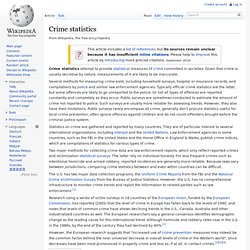

Besas
Schools of thought on criminology. Cesare Lombroso. Differential association. In criminology, Differential Association is a theory developed by Edwin Sutherland proposing that through interaction with others, individuals learn the values, attitudes, techniques, and motives for criminal behavior.

Differential association predicts that an individual will choose the criminal path when the balance of definitions for law-breaking exceeds those for law-abiding. This tendency will be reinforced if social association provides active people in the person's life. Earlier in life the individual comes under the influence of those of high status within that group, the more likely the individual to follow in their footsteps. Subculture. In sociology, and cultural studies, a subculture is a group of people within a culture that differentiates themselves from the larger culture to which they belong.

The term subculture has become deprecated among some researchers, who prefer the term co-culture, in order to avoid the connotations of inferiority associated with the "sub-" prefix.[1][2] While exact definitions vary, the Oxford English Dictionary defines the term as "a cultural group within a larger culture, often having beliefs or interests at variance with those of the larger culture. "[3] Definition[edit] Education. School children sitting in the shade of an orchard in Bamozai, near Gardez, Paktya Province, Afghanistan A right to education has been recognized by some governments.

At the global level, Article 13 of the United Nations' 1966 International Covenant on Economic, Social and Cultural Rights recognizes the right of everyone to an education.[2] Although education is compulsory in most places up to a certain age, attendance at school often isn't, and a minority of parents choose home-schooling, e-learning or similar for their children. Etymology[edit] Etymologically, the word "education" is derived from the Latin ēducātiō ("A breeding, a bringing up, a rearing") from ēdūcō ("I educate, I train") which is related to the homonym ēdūcō ("I lead forth, I take out; I raise up, I erect") from ē- ("from, out of") and dūcō ("I lead, I conduct").[3] Education can take place in formal or informal educational settings.
History[edit] Alcohol. Ball-and-stick model of the hydroxyl (-OH) functional group in an alcohol molecule (R3COH).

The three "R's" stand for carbon substituents or hydrogen atoms.[1] The hydroxyl (-OH) functional group with bond angle. Anthropological criminology. History[edit] The physiognomist Johann Kaspar Lavater (1741–1801) was one of the first to suggest a link between facial figures and crime.[1] Victor Hugo referred to his work in Les Misérables, about what he would have said about Thénardier's face.

Franz Joseph Gall then developed in 1810 his work on craniology, in which he alleged that crime was one of the behaviors organically controlled by a specific area of the brain. The philosopher Jacob Fries (1773–1843) also suggested a link between crime and physical appearance when he published a criminal anthropology handbook in 1820. The Italian school[edit] However, criminal anthropology per se refers to the Italian school of criminology, whose most famous member was Cesare Lombroso. Mugshot and fingerprinting[edit] On the other hand, Alphonse Bertillon (1853–1914) created a mugshot identification system for criminals prior to the invention of fingerprinting. Crime statistics.
Crime statistics attempt to provide statistical measures of crime committed in societies.

Given that crime is usually secretive by nature, measurements of it are likely to be inaccurate. Several methods for measuring crime exist, including household surveys, hospital or insurance records, and compilations by police and similar law enforcement agencies. Typically official crime statistics are the latter, but some offences are likely to go unreported to the police. Or not all types of offences are reported constantly and completely as they occur. Public surveys are sometimes conducted to estimate the amount of crime not reported to police. Statistics on crime are gathered and reported by many countries, They are of particular interest to several international organizations, including Interpol and the United Nations.
Two major methods for collecting crime data are law enforcement reports, which only reflect reported crimes and victimization statistical surveys. Counting rules[edit] Positivism. Positivism is a philosophy of science based on the view that information derived from logical and mathematical treatments and reports of sensory experience is the exclusive source of all authoritative knowledge,[1] and that there is valid knowledge (truth) only in scientific knowledge.[2] Verified data received from the senses are known as empirical evidence.[1] This view holds that society, like the physical world, operates according to general laws.

Introspective and intuitive knowledge is rejected. Population density. Population density (people per km2) by country, 2006.

Population density (people per km2) map of the world in 1994 (detailed). Population density (people per km2) map of the world in 1994. Deserts around the world. Compare with maps above. See also this image for location of densely populated areas (cities) in various vegetation zones. Population density (in agriculture standing stock and standing crop) is a measurement of population per unit area or unit volume; it is a quantity of type number density. Concentric zone model. Concentric zone model Commuter zone Residential zone Working class zone Factory zone The Concentric zone model also known as the Burgess model or the CCD model is one of the earliest theoretical models to explain urban social structures.

Juvenile delinquency. In recent years in the US the average age for first arrest has dropped significantly, and younger boys and girls are committing crimes.

Between 60–80% percent of adolescents, and pre-adolescents engage in some form of juvenile offense.[2] These can range from status offenses (such as underage smoking), to property crimes and violent crimes. The percent of teens who offend is so high that it would seem to be a cause for worry. However, juvenile offending can be considered normative adolescent behavior.[2] This is because most teens tend to offend by committing non-violent crimes, only once or a few times, and only during adolescence. It is when adolescents offend repeatedly or violently that their offending is likely to continue beyond adolescence, and become increasingly violent.